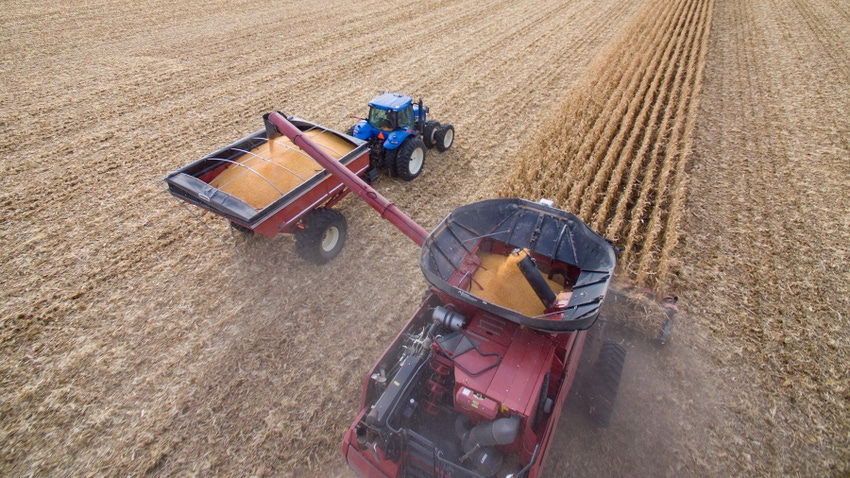
At a Glance
- Corn and soybean yields will be higher than last year, but still not great.
- Farm Futures grower survey projects yields of 175.2 bpa for corn and 51.2 bpa for soybeans.
- The price outlook is bearish for corn, bullish for soybeans.
Farmers and marketers alike are bracing for just average corn and soybean yields in Friday’s Crop Production and World Agricultural Supply Estimates reports from USDA, which will provide a first look at farmer expectations of 2023 corn and soybean yields.
The August 2023 Farm Futures survey of farmer readers across the country found that most growers are bracing for smaller yields this year. Farmers anticipate harvesting the nation’s fourth largest corn and third largest soybean yields, a far cry from the record-setting yields anticipated at the start of the 2023 growing season.
The 985 responding growers expect corn acres across the country to yield 175.2 bushels per acre in 2023, a slight 1% increase from last year’s yield of 173.3 bpa. For soybeans, Farm Futures readers expect the national average yield will be reported at 51.2 bpa, which would be a 3.5% uptick from 2022’s 49.5 bpa.
Both figures are significantly lower than USDA’s modeled estimates of 181.5 bpa for corn and 52.0 bpa for soybeans, but they reflect the widespread heat stress endured by Midwestern and Plains crops early in the growing season. Below average rainfall during Spring 2023 further exacerbated unfavorable growing conditions.
USDA made an uncharacteristic revision to 2023 corn yields in the July 2023 WASDE report, shrinking the estimate by 4 bpa to 177.5 bpa. USDA typically does not deviate from its trendline yield projections outlined at its Agricultural Outlook Forum in February, but since June 2023 rainfall volumes were exceptionally low in the top corn-producing states (falling in the lowest 10%-tail of its statistical distribution), a yield reduction for corn was warranted.
The lower yields should come as no surprise to growers who have been longing for rain all summer. Farm Futures readers are expecting to see significant annual decreases in self-reported yield estimates – 7% lower for corn and 8% lower for soybeans.
Pricing implications
Even though corn yields will be off trendline estimates this year, the 1% annual uptick in yield estimates calculated by Farm Futures survey respondents and the 6% increase in planted corn acreage will likely result in 15.122 billion bushels of corn being harvested this fall.
If realized, that would mean that the 2023 crop will be the second largest on record, trailing 2016’s record harvest of 15.148 billion bushels. If usage estimates remained fixed at current levels outlined in the July 2023 WASDE, 2023/24 ending corn stocks will grow by nearly half to 2.063 billion bushels.
That means an improvement to grain liquidity in the corn demand pipeline, as stocks-to-use ratios rise to 14.2% amid the larger supply forecast. That markets a departure from 2022/23 supply levels, which were the 11th tightest ending stocks on record.
But that also likely means that futures and basis prices will both face bearish headwinds as corn supplies rebuild following three years of historically tight stocks. Corn growers will be more reliant on export sales to help keep prices afloat in the coming months as the national corn stockpile grows.
Soybeans are less likely to face these same bearish pressures, largely due to a big acreage cut in USDA’s June 30 Acreage Report. Annual planted soybean acreage declined nearly 5% this spring to 83.5 million acres. With Farm Futures’ projected yield of 51.2 bpa for 2023 soybeans, this year’s soybean harvest will barely top 4.235 billion bushels.
At 51.2 bpa, that would be the sixth largest soybean crop harvested in the U.S. Recent weather events could help to push that figure higher, but supply levels are likely to keep U.S. soybean stocks tight for a fourth consecutive marketing year.
Even factoring smaller export volumes, higher domestic crush rates will keep soybean usage steady in the upcoming 2023/24 marketing year. If USDA keeps usage rates at current levels in Friday’s WASDE report, new crop ending stocks could shrink 8% lower to 235 million bushels.
That would tighten the new crop stocks-to-use ratio to 5.5% and put 2023/24 ending supplies at the 11th tightest on record, pushing down the current marketing year’s 5.9% stocks-to-use ratio to the 19th tightest in history.
That dynamic gives a higher chance of higher prices to soybeans than corn in Friday’s reports. But there are some conflicting considerations for soybean bulls.
Recent rains across the Midwest were warmly welcomed over the past weekend but likely provided more benefit to soybean pod development than corn kernel counterparts. Soybeans are currently finishing up their peak pod fill periods, while corn pollination across the country was quickly finishing as of early last week, based on Farm Futures’ Feedback from the Field series.
There is still a lot of time between now and early harvest activities, which are likely to hit full force within the next 40 days. Recent rains could provide a surprise boost to yields. Unforeseen storms could inflict harmful late season crop damage.
There could be a significant volume of yield variation over the next six to eight weeks, so keep that in mind when observing our yield estimates, as well as USDA’s initial look at yields on Friday.
About the Author(s)
You May Also Like






